John Charnley Award: Preoperative Patient-reported Outcome Measures Predict Clinically Meaningful Improvement in Function After THA
- PMID: 26201420
- PMCID: PMC4709271
- DOI: 10.1007/s11999-015-4350-6
John Charnley Award: Preoperative Patient-reported Outcome Measures Predict Clinically Meaningful Improvement in Function After THA
Abstract
Background: Despite the overall effectiveness of total hip arthroplasty (THA), a subset of patients remain dissatisfied with their results because of persistent pain or functional limitations. It is therefore important to develop predictive tools capable of identifying patients at risk for poor outcomes before surgery.
Questions/purposes: The purpose of this study was to use preoperative patient-reported outcome measure (PROM) scores to predict which patients undergoing THA are most likely to experience a clinically meaningful change in functional outcome 1 year after surgery.
Methods: A retrospective cohort study design was used to evaluate preoperative and 1-year postoperative SF-12 version 2 (SF12v2) and Hip Disability and Osteoarthritis Outcome Score (HOOS) scores from 537 selected patients who underwent primary unilateral THA. Minimum clinically important differences (MCIDs) were calculated using a distribution-based method. A receiver operating characteristic analysis was used to calculate threshold values, defined as the levels at which substantial changes occurred, and their predictive ability. MCID values for HOOS and SF12v2 physical component summary (PCS) scores were calculated to be 9.1 and 4.6, respectively. We analyzed the effect of SF12v2 mental component summary (MCS) scores, which measure mental and emotional health, on SF12v2 PCS and HOOS threshold values.
Results: Threshold values for preoperative HOOS and PCS scores were a maximum of 51.0 (area under the curve [AUC], 0.74; p < 0.001) and 32.5 (AUC, 0.62; p < 0.001), respectively. As preoperative mental and emotional health improved, which was reflected by a higher MCS score, HOOS and PCS threshold values also increased. When preoperative mental and emotional health were taken into account, both HOOS and PCS threshold values' predictive ability improved (AUCs increased to 0.77 and 0.69, respectively).
Conclusions: We identified PROM threshold values that predict clinically meaningful improvements in functional outcome after THA. Patients with a higher level of preoperative function, as suggested by HOOS or PCS scores above the defined threshold values, are less likely to obtain meaningful improvement after THA. Lower preoperative mental and emotional health decreases the likelihood of achieving a clinically meaningful improvement in function after THA. The results of this study may be used to facilitate discussion between physicians and patients regarding the expected benefit after THA and to support the development of patient-based informed decision-making tools. For example, despite significant disease, patients with high preoperative function, as measured by PROM scores, may choose to delay surgery given the low likelihood of experiencing a meaningful improvement postoperatively. Similarly, patients with notably low MCS scores might best be counseled to address mental health issues before embarking on surgery.
Level of evidence: Level III, prognostic study.
Figures


References
-
- Beswick AD, Wylde V, Gooberman-Hill R, Blom A, Dieppe P. What proportion of patients report long-term pain after total hip or knee replacement for osteoarthritis? A systematic review of prospective studies in unselected patients. BMJ Open. 2012;2:e000435. doi: 10.1136/bmjopen-2011-000435. - DOI - PMC - PubMed
-
- Braeken AM, Lochhaas-Gerlach JA, Gollish JD, Myles JD, Mackenzie TA. Determinants of 6–12 month postoperative functional status and pain after elective total hip replacement. Int J Qual Health Care. 1997;9:413–418. - PubMed
MeSH terms
LinkOut - more resources
Full Text Sources
Other Literature Sources
Medical
Research Materials

